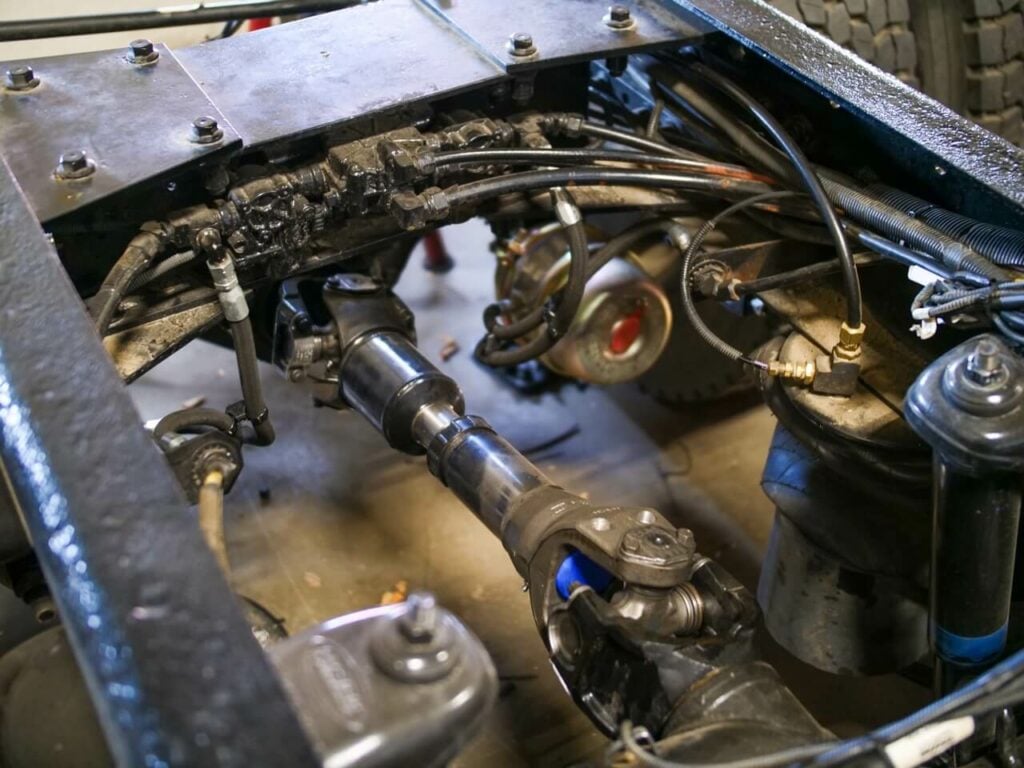The truck driveline is a less-known but crucial part of the engine in heavy-duty diesel trucks. It’s a system that includes all the gears and axles necessary to ensure that your truck can move quickly and efficiently. In simple terms, it shifts power (torque) from the engine and transmission to your wheels. That’s why it’s important to service your truck’s driveline.

The driveline system is located under the hood of your heavy-duty truck, made up of many parts. These include:
- Transfer Case
- Axles
- Driveshaft
- U-Joints/CV Joints
- Differential gears
Differential gears are devices for transmitting rotary motion smoothly. They are used to move wheels at an even speed when the vehicle turns corners, enabling different speeds on two wheels when traveling over a bumpy surface. The modern differential usually has a ‘friction’ clutch inside the casing to provide a limited-slip action when required.
A driveshaft is a rotating shaft that uses universal joints to transmit torque from one location to another. On heavy-duty trucks, these are used in tandem with couplings and U-joints to transfer the torque from the engine to the rear axle. When one of these parts fails, you need immediate professional help.
Driveline problems in a diesel engine can happen in various ways, including faulty axles and universal joints, the icing on the oil pan gasket or ring, and pinion gear failure.
Common Truck Driveline Solutions and Services for Heavy-Duty Trucks
We recommend flushing your front and rear differential flush. While most people know that their truck needs an oil change, not all know that their differential also requires service. Differentials are more complicated than many realize.
Differentials are at the end of your vehicle’s power train. Depending on your vehicle’s drive setup, they take power from the transmission and split it up to each tire on the front or back axle.
They work hard, and over time their gear oil breaks down, becoming thicker and less effective at transferring power. In addition to this, water tends to collect in the housing, causing rust. This can wreak havoc on the gears inside, leading to scratches, pitting, and even worse, stove piping or a complete failure.
When your differential is serviced, your mechanic will drain the fluid and replace it with fresh new oil with a universal viscosity. The differential inspection may reveal other problems such as cracked housing or damaged gear that need to be fixed separately.
Frequently Asked Questions
The driveline, also known as the drivetrain, is a group of components in your heavy-duty truck responsible for transferring power from the engine and transmission to the wheels, ultimately putting your truck in motion. It includes several critical parts: the driveshaft, which is the main rotating tube; the U-joints (universal joints), which allow the driveshaft to flex; the CV joints (constant-velocity joints); and the differential, which allows the wheels to rotate at different speeds when turning.
Driveline issues often present clear warning signs. The most common indicator is an unusual vibration that can be felt throughout the truck, particularly during acceleration. You might also hear strange noises, such as clunking, squeaking, or grinding sounds, especially when shifting gears or turning. Difficulty making tight turns or resistance from the wheels can also point to a problem with the differential or U-joints. If you notice any of these symptoms, a prompt inspection is crucial to prevent further damage.
Regular driveline maintenance is essential for the reliability and safety of your heavy-duty truck. Key components like the U-joints should be lubricated with every oil change to ensure smooth operation and prevent premature wear. A more thorough inspection of the entire driveline system should be conducted at least once a year. However, it’s important to consult your truck manufacturer’s recommended service intervals and consider your operating conditions, as heavy hauling or rough terrain may require more frequent service.
Scheduling Driveline Service at Inland Kenworth
To schedule service, fill out the form below or find the nearest location to you and get in touch.

